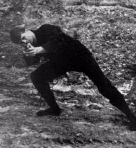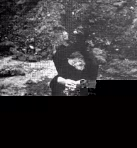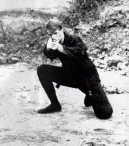Taijutsu and
Pistolcraft
by Charles Daniel
(from Ninja Special - Ninja Weapons
& Battle Strategy spring 1987)
In the ever-changing world of martial arts, weapons, costumes and styles seem to do a
never-ending dance to stay at the top. In the 50's it was judo, in the 60's it was karate and later the kung-fu explosion took place which was eventually followed by the current ninjutsu craze. Craze? Well yes. . . What would you call a fad that has been the basis for movies, novels and even toys. However, even here under all the flash and show that has surrounded ninjutsu, there is a form of martial art that has its own unique methods of dealing with some of the age-old problems of self defense. Weapons such as sticks, knives, Mace and even cords have been promoted by various writers and practitioners as "ultimate weapons for defense. " While all of these methods and tools can find a place within a person's defensive armor, none of them carry the deadly weight that guns do.
Anyone who claims to be teaching self defense without taking guns into account not only looks a little strange, but is probably dealing with less than a full deck. Guns, in all their various forms, have not and will not go away. Of course, if one is practicing a type of martial art that is not necessarily meant to be for self defense, then guns are rather beside the point.
The various non-gun (that is, non-self defense) arts make up an important segment of the giant subculture known as the martial arts. Arts such as judo, kendo and many styles of karate are intended for sporting contests, while tai-chi-chuan is normally practiced for its health benefits. In Japan, such arts as classical swordsmanship are practiced first and foremost as a link to that country's past. The purpose of any martial art must be clear before it is possible to say anything at all about the role played by such modern weapons as guns within that art. It should also be noted that just because a martial art does not take self defense as its central theme does not in any way devalue that art. The martial arts demand a balance of the concepts of "martial" and "art". This is one reason that, in many dojos, students are required to make an in depth study of the ideas and values of their school's (and its nation of origin's) history and culture. Not only does such study enlighten the student to the conditions under which the art developed, but it also helps balance the student's development as a person. It should be further noted that many of the seemingly strict rules that some schools have are not empty exercises devoid of meaning, but in fact are very rational methods of insuring the safety of all the people training in it.
The entire subject of guns is surrounded by emotional extremes. On one side are the "ban all guns" people while on the other the "guns don't kill people, people do" contingent stands its ground. An objective view of guns is difficult to obtain and, like most serious subjects, there are just no simple answers .
Many gun control advocates like to point out that in countries such as Japan and West Germany where guns are strictly controlled. the number of crimes involving firearms is very low. They seem to overlook, however, that guns were never widely available in
these countries and the number of available units is extremely low. In America, guns have been a way of life for a long time and even if their production was halted this instant, there would still be untold number of guns (and reloading equipment, already in circulation and readily available. After taking these simple facts into account, gun control would seem to be as tall an order as balancing the Federal budget.)
If the author's rather quick discussion of the gun control controversy would seem to label him a gun advocate, then the other position should be examined first. The statement that "guns don't kill people. . . " is just as untrue and unrealistic as the "ban all guns" platform. Any police officer who has ever walked a beat will tell you that guns do, in fact, kill people. The problem with any type of gun, be it a low caliber handgun or a high powered rifle, is that there is no "less than full-power technique.
For example: With a stick it is possible to convince someone to cease their assault without creating various and sundry leaks in their anatomy. It is very difficult, however. to "half-shoot" someone. Also. guns are very easy to use in this "heat of the moment, " or when the user is totally drugged or drunk. This has a lot to do with the reasoning behind the European knights and the Japanese samurais' hatred of firearms. Unlike swords, which generally kill exactly who they are supposed to, guns have a bad habit of killing anyone unlucky enough to be standing in the wrong place when the thing goes off.
As far as the harmlessness of the gun is concerned, the number of killings involving firearms would seem to show that the gun is always the weapon of choice. Anyone claiming that murders would be committed with some other weapon if guns were not available seems to accept that
the ability to kill at close range with a knife or bare hands is natural to the human animal. If this were the case, then there would be no need to train military personnel in the skills of unarmed combat.
|
The point of the above statements is to emphasize just how difficult the entire gun question is to the martial artist. Probably the best thing one can do is to find their own position on the question and train accordingly . It should be realized, however, that some gun related skills will forever be beyond the abilities of many martial artists. Performing techniques that involve the disarming of a gun wielding attacker is equal in difficultly to disarming a skilled swordsman. These techniques are not impossible but are highly doubtful for the majority of martial artists. Working in a controlled atmosphere where a mistake is "okay" is one thing-facing the business end of a loaded gun is something entirely different.
|
 |
|
Attempting to disarm someone with a gun is something, most experts agree, that should be tried only if one is certain that they will be shot whether or not the attempt is made. In this case there is little to lose. If one tries a disarm when the gunman is unsure of his intentions, then he will help his assailant decide what to do (generally to start shooting) rather quickly. For the purposes of this article, we will not be discussing gun disarms, however, some things can be said about the approach to gun techniques and how these techniques relate to martial arts in general and unarmed techniques in particular.
|
 |
|
Before even beginning to look at the relationship between guns and other elements of the martial arts, it is important to be clear on what any particular firearm is intended for. Handguns were designed to fill a very different need than rifles, and shotguns are best used for even different situations. In very general terms, handguns are best for close range use such as inside the home or under conditions which require that the firearm be carried concealed or " out of the way . " Evidence collected by a variety of agencies indicates that the majority of handgun firefights take place at a distance of under 21 feet.
|
 |
In the last few years, there has been a growing controversy over the relative stopping power of various handguns, and while much of this makes for some interesting reading (and some rather silly movies where the caliber of the hero's handgun is more the focus than the storyline), the whole issue has little to do with the martial artist. The major concern of anyone who trains with a handgun should be their skill at hitting the target, regardless of the type of weapon they are using. It should be noted that the people who profit most from the "stopping power" issue are the gun manufacturers. (Author's note: This is not unlike the martial arts supply business which needs a regular change in fashion to help keep themselves " in the black " .)
In terms of training, most martial artists would probably be best advised to learn what is called " instinctive shooting", which involves being able to hit a target without taking the time to use the weapon's sights. This type of shooting is practiced by first shooting at targets set at very close ranges and then moving the targets back as the shooter develops skill and confidence. At close range with a handgun, there is rarely time to bother with sighting-this type of shooting is very similar in terms of body dynamics to throwing a punch or a knife. For training purposes a common BB air pistol can be used because, at the ranges in which a handgun is most likely to be used. the air pistol will shoot straight enough to polish one's skills without attracting the attention of the local authorities. Experience with live weapons is essential, however, as a shooter will need to become accustomed to noise and recoil. Shooting should be practiced in such a way as to incorporate as many different motions as possible - rolling, dropping and even jumping should be practiced. Knowing the difference between cover (something one can hide behind without having to worry about getting shot through it) and concealment (which will hide you but provides no protection) is of little use if one is too slow to get behind the stuff.
|
In the realm of weapons such as shotguns and submachine guns, a few words should be said. Shotguns are probably best left to hunters or in the home as a defense against intruders. The idea that one can simply point one of these weapons in the general direction of their target and hit it every time is a myth founded on so many stupid movies Shotguns are dangerous at close quarters (What gun isn't) but they hardly deserve the reputation they have been given of being easily handled and wielded by all. For the average person, the recoil and noise of these weapons combined with the fact that they are
unconceivable would eliminate them as a general purpose self defense weapon.
The case of submachine guns is fairly simple to address. Most importantly, they are, by Federal law totally illegal for the private citizen to own. Now there are a number of readers who will say that the historical ninja had little regard for the law, but these individuals should remember that the historical ninja operated under conditions of war where the rule book is always the first thing to be thrown out the window.
|
 |
|
In today's world any writer claiming that ninjutsu practitioners don't have to follow the dictates of society should be locked away with the rest of the world's dangerously deranged. While it may be appealing to tell your friends about the great weapon you have at home that just happens to be illegal it is doubtful that this will be very impressive when you end up in a jail cell.
Outside of hunting, rifles also have little to offer the martial artist These weapons have a much longer range than the other weapons mentioned in this article and is one reason why they are so closely associated with basic military training and not personal defense. |
 |
|
As can be deduced from this article, the entire subject of guns is difficult to address when relating them to the martial arts The positive side is the firearm's ability to t make people "even" in term of strength. Also, guns
don't get tired and are not effected by a person's health or age the way that martial arts skills can be on the negative side, a number of gun owners have been shot with their own weapons and innocents are sometimes killed by accidental discharges or simple bad aim. The answers to this difficult dilemma are as varied as the personalities addressing it, however, if one is determined to learn to use and carry a gun, then the best place to start would be at the local police station to learn about local laws and inquire as to where quality training can be obtained. If this is not possible and one still has an interest, then local hunting clubs or even the armed forces are places where such information can be found.
Firearms training is a martial art like any other but has an added lethal twist because there is no "half way technique", training should be
approached with this in mind. The care that should be exercised when training and practicing with guns can not be overemphasized and should never, never be taken lightly. Its one thing to hit a training partner with a stray punch where an "I'm Sorry' ' and a band-aid will suffice, but quite another when the punch is measured by caliber. |

 |
This article reprinted from the
Mahoutsukai Dojo, with permission.
|



